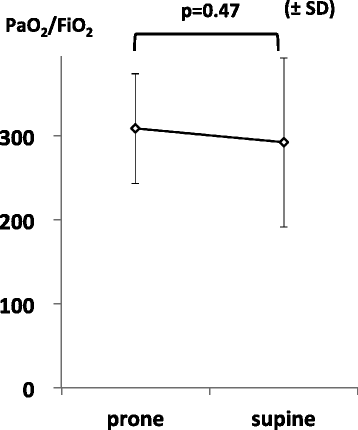Oxygenation improves during the first 8 h of extended-duration prone positioning in patients with respiratory failure: a retrospective study
- PMID: 25705410
- PMCID: PMC4336245
- DOI: 10.1186/s40560-014-0052-5
Oxygenation improves during the first 8 h of extended-duration prone positioning in patients with respiratory failure: a retrospective study
Abstract
Background: A recent multicenter trial demonstrated decreased mortality when patients with acute respiratory distress syndrome were treated with prone positioning (PP). However, the optimal duration of this treatment has not been established.
Methods: From May 2010 to August 2013, 15 patients with respiratory failure underwent extended-duration prone positioning (more than 40 h) in the medical-surgical intensive care unit of a university hospital. The records of each patient were retrospectively investigated to evaluate the impact of prone positioning on the PaO2/FiO2 ratio (PFR) during the first 40 h of therapy.
Results: The mean age of the patients was 72.2 ± 7.8 years, and the mean Acute Physiology and Chronic Health Evaluation II score was 19.0 ± 6.0. The hospital mortality rate was 47% (7/15), and the median duration of prone positioning was 47.5 h (46.5-67). The mean PFR before prone positioning was 193.8 ± 70.1, and it significantly improved to 274.7 ± 70.7 (p = 0.02) at 8 h after prone positioning initiation. Although PFR further improved to 294.1 ± 78.0 (p = 0.23) at 16 h, the change was not significant and PFR remained relatively constant at 289.0 ± 88.1, 294.6 ± 68.2, and 291.7 ± 72.7 at 24, 32, and 40 h, respectively.
Conclusions: Extended-duration prone positioning resulted in a progressive improvement in oxygenation until 8 to 16 h after treatment initiation, after which there was no significant improvement. Further studies are warranted to clarify the optimal duration of prone positioning and the actual effectiveness of extended-duration PP for respiratory failure.
Keywords: Oxygenation; Prone positioning; Respiratory failure.
Figures


Similar articles
-
Prone positioning improves oxygenation in adult burn patients with severe acute respiratory distress syndrome.J Trauma Acute Care Surg. 2012 Jun;72(6):1634-9. doi: 10.1097/TA.0b013e318247cd4f. J Trauma Acute Care Surg. 2012. PMID: 22695433
-
Combined effects of prone positioning and airway pressure release ventilation on gas exchange in patients with acute lung injury.Acta Anaesthesiol Scand. 2003 May;47(5):516-24. doi: 10.1034/j.1399-6576.2003.00109.x. Acta Anaesthesiol Scand. 2003. PMID: 12699507 Clinical Trial.
-
Short-term effect of inhaled nitric oxide and prone positioning on gas exchange in patients with severe acute respiratory distress syndrome.Crit Care Med. 2000 Feb;28(2):304-8. doi: 10.1097/00003246-200002000-00002. Crit Care Med. 2000. PMID: 10708157
-
Prone positioning in acute respiratory distress syndrome.Nurs Stand. 2015 Aug 12;29(50):34-9. doi: 10.7748/ns.29.50.34.e9261. Nurs Stand. 2015. PMID: 26264335 Review.
-
Prone position in acute respiratory distress syndrome.Eur Respir J. 2002 Oct;20(4):1017-28. doi: 10.1183/09031936.02.00401702. Eur Respir J. 2002. PMID: 12412699 Review.
Cited by
-
Efficiency of Prolonged Prone Positioning for Mechanically Ventilated Patients Infected with COVID-19.J Clin Med. 2021 Jul 1;10(13):2969. doi: 10.3390/jcm10132969. J Clin Med. 2021. PMID: 34279453 Free PMC article.
-
Protracted course of coronavirus disease with severe acute respiratory distress syndrome: a case report.Acute Med Surg. 2020 Jun 18;7(1):e521. doi: 10.1002/ams2.521. eCollection 2020 Jan-Dec. Acute Med Surg. 2020. PMID: 32566237 Free PMC article.
-
Extended prone positioning for intubated ARDS: a review.Crit Care. 2023 Jul 5;27(1):264. doi: 10.1186/s13054-023-04526-2. Crit Care. 2023. PMID: 37408074 Free PMC article. Review.
-
The effects of prolonged prone positioning on response and prognosis in patients with acute respiratory distress syndrome: a retrospective cohort study.J Intensive Care. 2025 May 7;13(1):24. doi: 10.1186/s40560-025-00795-x. J Intensive Care. 2025. PMID: 40336057 Free PMC article.
References
-
- Gattinoni L, Tognoni G, Pesenti A, Taccone P, Mascheroni D, Labarta V, Malacrida R, Di Giulio P, Fumagalli R, Pelosi P, Brazzi L, Latini R, Prone-Supine Study Group Effect of prone positioning on the survival of patients with acute respiratory failure. N Engl J Med. 2001;345:568–573. doi: 10.1056/NEJMoa010043. - DOI - PubMed
-
- Guerin C, Gaillard S, Lemasson S, Ayzac L, Girard R, Beuret P, Palmier B, Le QV, Sirodot M, Rosselli S, Cadiergue V, Sainty JM, Barbe P, Combourieu E, Debatty D, Rouffineau J, Ezingeard E, Millet O, Guelon D, Rodriguez L, Martin O, Renault A, Sibille JP, Kaidomar M. Effects of systematic prone positioning in hypoxemic acute respiratory failure: a randomized controlled trial. JAMA. 2004;292:2379–2387. doi: 10.1001/jama.292.19.2379. - DOI - PubMed
-
- Mancebo J, Fernández R, Blanch L, Rialp G, Gordo F, Ferrer M, Rodríguez F, Garro P, Ricart P, Vallverdú I, Gich I, Castaño J, Saura P, Domínguez G, Bonet A, Albert RK. A multicenter trial of prolonged prone ventilation in severe acute respiratory distress syndrome. Am J Respir Crit Care Med. 2006;173:1233–1239. doi: 10.1164/rccm.200503-353OC. - DOI - PubMed
-
- Taccone P, Pesenti A, Latini R, Polli F, Vagginelli F, Mietto C, Caspani L, Raimondi F, Bordone G, Iapichino G, Mancebo J, Guérin C, Ayzac L, Blanch L, Fumagalli R, Tognoni G, Gattinoni L, Prone-Supine II, Study Group Prone positioning in patients with moderate and severe acute respiratory distress syndrome: a randomized controlled trial. JAMA. 2009;302:1977–1984. doi: 10.1001/jama.2009.1614. - DOI - PubMed
-
- Guérin C, Reignier J, Richard JC, Beuret P, Gacouin A, Boulain T, Mercier E, Badet M, Mercat A, Baudin O, Clavel M, Chatellier D, Jaber S, Rosselli S, Mancebo J, Sirodot M, Hilbert G, Bengler C, Richecoeur J, Gainnier M, Bayle F, Bourdin G, Leray V, Girard R, Baboi L, Ayzac L, PROSEVA Study Group Prone positioning in severe acute respiratory distress syndrome. N Engl J Med. 2013;368:2159–2168. doi: 10.1056/NEJMoa1214103. - DOI - PubMed
LinkOut - more resources
Full Text Sources
Other Literature Sources
Miscellaneous

